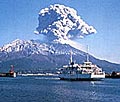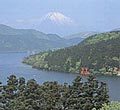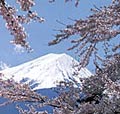 |
General
Info |
| Geography
|
 |
 As
an island nation, Japan comprises of over 1000 small islands and four
larger ones, namely Honshu (slightly larger than Britain), Hokkaido, Kyushu,
and Shikoku. Among the smaller islands, Okinawa is the largest and most
significant. As
an island nation, Japan comprises of over 1000 small islands and four
larger ones, namely Honshu (slightly larger than Britain), Hokkaido, Kyushu,
and Shikoku. Among the smaller islands, Okinawa is the largest and most
significant.
Japan stretches along
an archipelago that extends from the western tip of Honshu all the way
to Taiwan. Its unique location of being apart from the Asian mainland
help form and define its culture into what it is today.
Japan's total land area
is 377,435 sq. km, with more than 80 percent of it being mountainous.
A chain of islands stretches across a 3000 km-long arc of mountains along
the eastern rim of the Asian continent.
 Japan's
mountainous topography is rather interesting. Most mountains are volcanic
with more than 40 of it presently active. Numerous hot springs and breathtaking
scenery are the results of volcanic mountains although there is always
the constant danger of frequent eruptions and intense seismic activity.
Rough earthquakes, volcanic eruptions, tsunami (tidal waves), and monsoon
climates make up part of the lifestyle in Japan. Japan's
mountainous topography is rather interesting. Most mountains are volcanic
with more than 40 of it presently active. Numerous hot springs and breathtaking
scenery are the results of volcanic mountains although there is always
the constant danger of frequent eruptions and intense seismic activity.
Rough earthquakes, volcanic eruptions, tsunami (tidal waves), and monsoon
climates make up part of the lifestyle in Japan.
 The
weather in Japan is rather complex due to its mountainous territory. For
example, Hokkaido in the north has short summers and long winters with
heavy snowfalls while Ryukyu Islands in the south enjoy a subtropical
climate. There is also a high degree of seasonal variation. The
weather in Japan is rather complex due to its mountainous territory. For
example, Hokkaido in the north has short summers and long winters with
heavy snowfalls while Ryukyu Islands in the south enjoy a subtropical
climate. There is also a high degree of seasonal variation.
 The
meeting of cold, dry air from Siberia and warmer, moister air from the
Pacific produces huge snowfalls in the western area of Japan. On the eastern
side, however, it does not snow as much but it can still get very cold. The
meeting of cold, dry air from Siberia and warmer, moister air from the
Pacific produces huge snowfalls in the western area of Japan. On the eastern
side, however, it does not snow as much but it can still get very cold.
 High
temperatures and humidity cover most of Japan during the summer due to
warm, moist air currents from the Pacific. Nonetheless, rains occur in
the early summer and again towards the end of summer. High
temperatures and humidity cover most of Japan during the summer due to
warm, moist air currents from the Pacific. Nonetheless, rains occur in
the early summer and again towards the end of summer.
 Clear
days, mild weather and low rainfall help make up for the harsh winter
and summer. This would be the best time to visit Japan, with beautiful
clear skies that contribute even more to the spectacular scenery of this
country. Clear
days, mild weather and low rainfall help make up for the harsh winter
and summer. This would be the best time to visit Japan, with beautiful
clear skies that contribute even more to the spectacular scenery of this
country.
Top of Page
|
